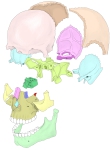口蓋骨 ( こうがいこつ、英:palatine bone )
|
|
あ行 |
さ行 |
は行 |
鼻腔面(垂直板) |
||||
か行 |
た行 |
||||||
|
|
||||||
|
|||||||
さ行 |
|
【横口蓋縫合、おうこうがいほうごう、英:transverse palatine suture】
【眼窩突起、がんかとっき、英:orbital process】
【口蓋上顎縫合、こうがいじょうがくほうごう、英:palatomaxillary suture】
= 水平板
・「関連語句」トップに戻る ・ページトップに戻る
【口蓋面、こうがいめん、英:palatine surface】
【後鼻棘、こうびきょく、英:posterior nasal spine】
【篩骨稜、しこつりょう、英:ethmoidal crest】
【上顎板、じょうがくばん、英:perpendicular plate of palatine bone】
= 垂直板
・「関連語句」トップに戻る ・ページトップに戻る
【上顎面、じょうがくめん、英:maxillary surface】
【小口蓋管、しょうこうがいかん、英:lesser palatine canel】
【小口蓋孔、しょうこうがいこう、英:leseer palatine foramen】
【垂直板、すいちょくばん、英:perpendicular plate】
【水平板、すいへいばん、英:horizontal plate】
【正中口蓋縫合、せいちゅうこうがいほうごう、英:transverse palatine suture】
【イラスト/写真】
① 標本と思われる写真を掲載しているサイト(内側方からみたもの)
② 標本と思われる写真を掲載しているサイト(外側方から見たもの)
③ 標本と思われる写真を掲載しているサイト(下部からみたもの)
④ 標本と思われる写真を掲載しているサイト(内側方からみたもの)
【解 説】
① 船戸和弥のホームページ
② ウィキペディア
In anatomy, the palatine bones (/ˈpælətaɪn/[1][2]) are two irregular bones of the facial skeleton in many animal species, located above the uvula in the throat. Together with the maxillae, they comprise the hard palate. (Palate is derived from the Latin palatum.)
【Structure】
The palatine bones are situated at the back of the nasal cavity between the maxilla and the pterygoid process of the sphenoid bone.
They contribute to the walls of three cavities: the floor and lateral walls of the nasal cavity, the roof of the mouth, and the floor of the orbits. They help to form the pterygopalatine and pterygoid fossae, and the inferior orbital fissures.
【 語 句 】
・facial skeleton:顔面頭蓋 ・uvula:口蓋垂 ・maxillae:maxilla(上顎骨)の複数形 ・hard palate:硬口蓋 ・nasal cavity:鼻腔 ・pterygoid process of the sphenoid bone:蝶形骨の翼状突起 ・orbit:眼窩 ・pterygoidpalatine fossa:翼口蓋窩 ・pterygoid fossa:翼突窩 ・inferior orbital fissure:下眼窩裂
Each palatine bone somewhat resembles the letter L, and consists of a horizontal plate, a perpendicular plate, and three projecting processes — the pyramidal process, which is directed backward and lateral from the junction of the two parts, and the orbital and sphenoidal processes, which surmount the vertical part, and are separated by a deep notch, the sphenopalatine notch. The two plates form the posterior part of the hard palate and the floor of the nasal cavity; anteriorly, they join with the maxillae. The two horizontal plates articulate with each other at the posterior part of the median palatine suture and more anteriorly with the maxillae at the transverse palatine suture.
【 語 句 】
・horizontal plate:水平板 ・perpendicular plate:垂直板 ・pyramidal process:錐体突起 ・orbital process:眼窩突起 ・sphenoidal process:蝶形骨突起 ・surmount:載せる ・sphenopalatine notch:蝶口蓋切痕 ・articulate with ~:~と接合する ・transverse palatine suture:横口蓋縫合
The human palatine articulates with six bones: the sphenoid, ethmoid, maxilla, inferior nasal concha, vomer and opposite palatine.
There are two important foramina in the palatine bones that transmit nerves and blood vessels to this region: the greater and lesser palatine. The larger greater palatine foramen is located in the posterolateral region of each of the palatine bones, usually at the apex of the maxillary third molar. The greater palatine foramen transmits the greater palatine nerve and blood vessels. A smaller opening nearby, the lesser palatine foramen, transmits the lesser palatine nerve and blood vessels to the soft palate and tonsils. Both foramina are openings of the pterygopalatine canal that carries the descending palatine nerves and blood vessels from the pterygopalatine fossa to the palate.[3]
【 語 句 】
・sphenoid:蝶形骨 ・ethmoid:篩骨 ・maxilla:上顎骨 ・inferior nasal concha:下鼻甲介 ・vomer:鋤骨 ・foramina:foramen(孔)の複数形 ・greater palatine foramen:大口蓋孔 ・lesser palatine foramen:小口蓋孔 ・molar:臼歯 ・soft palate:軟口蓋 ・tonsil:扁桃 ・pterygopalatine canal:翼口蓋管



















